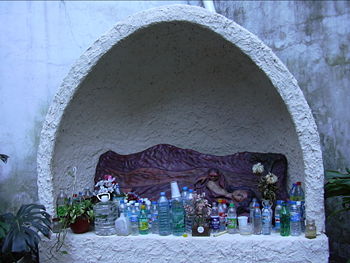Folk saint

Bottles of water are offered to Difunta Correa in commemoration of her death by thirst.
A folk saint is a deceased person or other spiritually powerful entity that is venerated as a saint but who has not been officially canonized by the Church. Like the officially recognized saints, folk saints act as intercessors with God on behalf of supplicants but many also act directly in the lives of their devotees. Their actions, in life as well as in death, distinguish them from their canonized counterparts: their ranks are filled by folk healers, sinners and pre-Hispanic spirits. Some are as likely to grant a request to curse an enemy or protect a drug runner as to heal a family member. Folk saints are popular in Latin America, where most have small followings, but a few are celebrated at the national or even international level. Template:TOC-left
Folk saints and the Church
Folk saints tend to be much more ambivalent in character than the members of the official Catholic pantheon and most are unlikely to ever be considered for canonization by the Church. This ambivalence may be traced back to their place in the community during life and the syncretic mixing of European and Native American cultures that has created folk saints.
With the exception of a few whose histories have been invented from whole cloth, folk saints come from the same communities as their followers. They suffered poverty and injustice and many died as victims of violence. In death, they continue to act in a more worldly fashion than their official counterparts.
Folk saints are also associated with the indigenous nature spirits and deities that permeated the landscape and cultures of pre-Hispanic America through the syncretism that created them. In fact, to distinguish canonized saints from folk saints, the latter are often called "spirits" instead of saints. Whereas the saints of the Catholic pantheon reside in heaven where they may be called upon to petition God on the behalf of their devotees, indigenous spirits were immanently present in the natural environment and interceded directly in the lives of those who called on them.
During the Counter-Reformation in Europe, the Council of Trent released a decree "On the Invocation, Veneration, and Relics, of Saints, and on Sacred Images." The decree explained that in Catholic doctrine images and relics of the saints are to be used by worshipers to help them contemplate the lives of the saints and the virtues that they represent but that those images and relics do not actually embody the saints.[1] As such, images and relics may be used as devotional aids but should not themselves be considered objects of devotion. To do so would constitute idolatry.
In New Spain during the same period some of the first syncretic ancestors of modern folk saints appeared. In Mesoamerican tradition, representation meant embodiment rather than mere resemblance, as it did in Europe.[2] Thus, for the Aztecs, Mayas and other Mesoamerican peoples, images took on the characters and spirits of the represented. This perspective lives on in the visits that devotees pay to many folk saints, especailly those that arise from syncretic mixing of pre-Hispanic gods and spirits with personalities or ideas with Catholic provenance. Visitors frequently interact with representations of folk saints as though they were interacting with another person, observing the proper etiquette for speaking to a patron or a friend depending on the spirit's disposition, shaking hands, or touching it in other ways. Offerings include the votive candles offered to the canonized saints but might also include placing a cigarette in its mouth or serving it alcohol.
In spite of their differences, folk saints often share space with their canonized counterparts and devotions to the official saints frequently take on aspects of devotions to folk saints. In certain areas, representations of the saints, embodying the spirits of the saints that are represented, take on a life of their own: Lois Parkinson Zamora points out that images of the same saint frequently take on different histories in different towns of central Mexico.[3]
Devotions
One might pay a visit to a folk saint for any number of reasons, including general requests for good health and good luck, the lifting of a curse, or protection on the road, but most folk saints have specialties for which their help is particularly sought. Difunta Correa, for example, specializes in helping her followers to acquire new homes and businesses. Juan Bautista Morillo helps gamblers in Venezuela and Juan Soldado watches over border crossings between Mexico and the United States. This is not so different from the canonized saints of the Church — St. Benedict, for example, is the patron saint of agricultural workers — but it would be hard to find a canonized saint to look after narcotraffickers, as does Jesus Malverde.
Many folk saints attract devotees precisely because they respond to requests that the official saints are unlikely to respond to. As James Griffith writes, "One needs ask for help where the help is likely to be effective."[4] So long as followers come before them with faith and perform the proper devotions, many folk saints are as willing to place a curse on a person as to lift one. As long as the spirits come through for their followers, their devotees will keep coming back.
References
- ↑ Lois Parkinson Zamora. 2006. The Inordinate Eye: New World Baroque and Latin American Fiction. Chicago: The University of Chicago Press.
- ↑ Zamora 2006, p. 20
- ↑ Zamora 2006, p. 13.
- ↑ James s. Griffith. 2003. Folk Saints of the Borderlands: Victims, Bandits & Healers. Tucson: Rio Nuevo Publishers. p. 19.